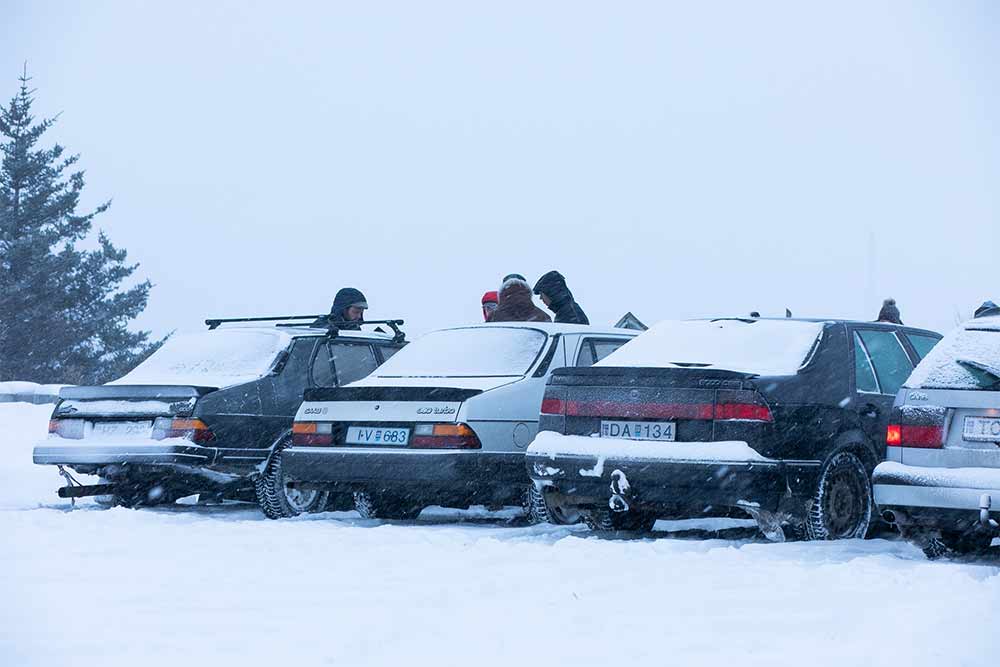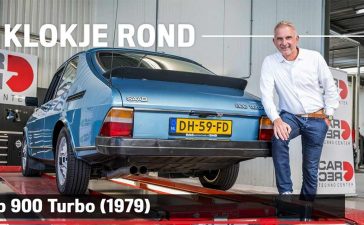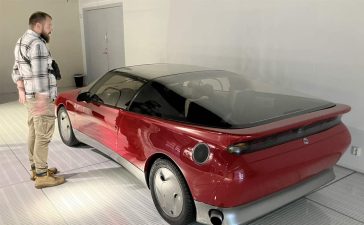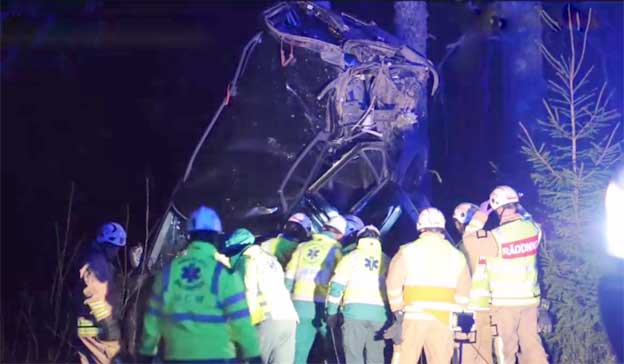Saab stories rarely follow predictable arcs. They come from barns, frozen hangars, scrapyards on the edge of towns no one can pronounce, or from family garages where a parent passes on more than a set of keys. Every so often, one of those stories reaches far beyond the car itself – it reveals a culture, a landscape, and a bond between a driver and a machine that seems almost unreasonable in 2025.
That is exactly what happens in the latest video by TJ Lamb of Magnacars, a Canadian creator whose channel unexpectedly stumbled upon one of the most compelling Saab narratives to come out of Iceland in recent years. The video, titled “Why I Drive a Saab 900 Turbo in Iceland,” is not just a showcase of a classic 1983 Saab. It is a window into an enthusiast ecosystem shaped by volcanic gravel roads, unpredictable weather, and a remarkably small pool of surviving Saab 900 Turbos on the island.
The car in question belongs to Kristinn (“Kiddi”), a young Saab enthusiast from Reykjavík whose relationship with this particular 900 Turbo stretches back two decades – long before he ever sat behind the wheel himself.
A Family Story Hidden Beneath Icelandic Paint and Steel
What makes Kiddi’s Saab 900 Turbo remarkable is not a single moment of discovery, but the way it returned to the family. The car’s journey starts in 2003, when Kiddi’s father – the president of the Icelandic Saab Club — bought a tired, red and rusty example of an early flat-nose Turbo. He brought it home not as a collector’s piece, but as a car worth saving.

Twenty years ago, classic Saabs in Iceland were already rare, and flat-nose 900 Turbos were nearly mythical. Importing parts was expensive. Rust repair alone was often enough to make a car uneconomical to restore. Still, Kiddi’s father revived the Saab and drove it long enough to pass it on to a close friend – a decision that would shape the next chapter of the car’s life.
By 2007, that friend had transformed the car visually into almost the same configuration seen today. More importantly, he used it as the wedding car for Kiddi’s parents – a detail that gives this thin-window, early-’80s Turbo an emotional weight far beyond its spec sheet. But cars migrate, and in 2015 it left the circle again, changing hands before gradually slipping into mechanical dormancy.
Three years later, the phone rang.
The man who bought it couldn’t get it running anymore. A broken steering rack left it immobilized in a barn. It sat unused, unwanted, and nearly forgotten – the classic Saab path to oblivion. But unlike so many 900s scattered across Europe’s rural barns, this one had a tether.
Kiddi and his father trailered the car back to Reykjavík. Together, they fixed the steering, brought the drivetrain back to life, and restored the mechanical heart of a vehicle already carrying two decades of family history.That moment — a son reviving the car his father once restored — sits at the emotional center of this story. It’s not nostalgia. It’s continuity.
Building a Uniquely Icelandic Saab: Practical Choices Meet Personal Taste
The reason this 900 stands out is not simply because it survived. It’s because its configuration reflects Iceland’s realities: harsh roads, limited local parts availability, and a tiny community of classic Saab owners who rely heavily on European suppliers.
This isn’t a museum-grade 900 Turbo. It’s a living car, shaped by practicality and personality.
Brake System Modernization
Early 900 Turbos – especially flat-nose models – used a front-handbrake setup tied into the front rotors. That layout works, but it’s quirky, parts are harder to source, and wheel fitment is limited. Kiddi upgraded the system to the later rear-handbrake configuration, opening the door to a modernized wheel setup.
For a country with steep hills, unpredictable surfaces, and a limited season for classic cars, this is more than an upgrade – it’s a necessity.
Mitsubishi Outlander Black: An Unexpected Paint Choice
The Saab now wears Mitsubishi Outlander black, contrasted by gray spoilers. It might sound unusual, but the color suits the Saab’s angular geometry. Black transforms the flat-nose design into something sharper, more deliberate. On Iceland’s overcast days, where the sky often blends into the lava fields, the paint gives the car a clean, purposeful presence.
The Three-Spoke Wheels and a 1979 Grille
Saab people argue endlessly about wheels and grilles. Here, Kiddi’s choices feel almost philosophical:
- Three-spoke wheels – arguably the most symbolic Saab wheel ever made – because they simply felt right to him.
- A 1979 grille, chosen purely on aesthetic preference, giving the flat-nose a slightly earlier, more iconic look.
These are enthusiast decisions, not collector decisions. They reflect someone building a car to suit his eye, his roads, and the version of Saab history he wants to preserve.
Hunting Down Rare Parts in Holland and Sweden
One detail TJ highlights is the large rear spoiler – a piece Kiddi sourced in the Netherlands. That alone tells you everything about owning a Saab in Iceland. The country’s entire population could fit into a mid-sized European city; expecting a warehouse of 900 Turbo parts locally would be wishful thinking.
Most Icelandic Saab parts come from:
- Holland
- Sweden
- Occasionally Great Britain
And they arrive slowly, expensively, and usually requiring adaptation.
The spoiler, the grille, and various trim pieces aren’t just aftermarket upgrades – they’re proof that keeping a classic Saab alive in Iceland takes resourcefulness.
A Closer Look at the Turbocharged Heart of the Beast
Pop the hood and the story becomes mechanical.
The 900 Turbo’s B202 16-valve engine is already a legendary powerplant in Saab circles. But this example has lived several enthusiast lifetimes. When the previous owner rebuilt it, he added:
- a larger turbo
- a higher-flow intercooler setup
- a custom downpipe
- an oversized exhaust system
- supporting upgrades to ensure reliable boost under load
Kiddi himself later renovated the engine and gearbox, preparing the car for a second life under his ownership.
Power output?
It depends — and that’s not a joke.
“If everything is working,” he says, “maybe around 230 horsepower.”
Saab people smile at that line because they know the truth: old 900 Turbos have moods. When the air is right, when the boost lines are sealed, when the valves are adjusted just so, they remind the driver why Saab engineers approached turbocharging differently from everyone else.
With a curb weight around 1,200 kg, 230 hp in a classic 900 feels more alive than numbers ever suggest.
The Transmission Swap: Five Gears Out, Four Gears In
One of the most interesting choices Kiddi reveals is his upcoming transmission change: replacing the 5-speed manual with a stronger 4-speed. To outsiders, this sounds like a downgrade. In Saab engineering lore, it’s the opposite.
The classic 900’s 5-speed front-drive gearbox is notorious. It can handle spirited driving, but the four-speed is the tough one, built like a block of granite. For a car living on Icelandic roads – where potholes, gravel, and sudden traction changes are the norm – durability matters. This is a mechanical choice born from geography.
From American Soldier to Icelandic Family Car: A Rare Import Story
Classic Saab import histories are usually Swedish, occasionally Dutch, and sometimes British. This one is different. The 900 Turbo was originally purchased as a U.S.-spec car by an American serviceman stationed at Keflavík Airport, long before Iceland shut down the U.S. military presence there.
He bought it new. Imported it immediately to Iceland. Left it behind when he returned to the U.S. It’s rare enough to find a well-preserved 1983 900 Turbo. Finding a U.S.-spec car that never actually lived in the U.S. adds another layer of cultural and historical texture to this machine. This flat-nose Turbo is more than a car. It’s a leftover artifact of a geopolitical presence that shaped Icelandic life for decades.
Life With a Classic Saab in Iceland — The Reality, the Road, and the Ride
Driving a 900 Turbo in Iceland is far from gentle. The roads are uneven, often unpaved, and the driving season is short. Even so, Kiddi uses his Saab almost daily in summer, and people notice it because so few remain on the road.
Most Icelandic 900 Turbos vanished for the same reasons: rust in the front suspension mounts and fenders, failing transmissions, and the cost of importing every major part from Europe. This one survived only because Kiddi and his father refused to give up on it.
TJ understands the car’s character the moment he gets in. The steering, the boost, and the chassis feedback arrive without any filter. The unusual Saab layout – the rear-tilted B202 sitting over a forward-mounted gearbox – gives the car a feel that no other ’80s machine can replicate.
This car carries more than mechanical interest. It lived through Iceland’s climate, returned to the same family after years away, served as a wedding car, and was revived after being left idle. It’s a functional piece of family history, not a museum piece.
Kiddi’s 900 Turbo shows how much commitment it takes to keep a classic Saab alive in Iceland, and TJ Lamb’s video captures that reality clearly – the roads, the challenges, and the satisfaction of driving something few others have managed to preserve.
To experience the full story – the sound, the roads, the personality of the car – watch the embedded video below. It’s a rare look into a corner of the Saab world few get to see, straight from the lava fields of Iceland.











